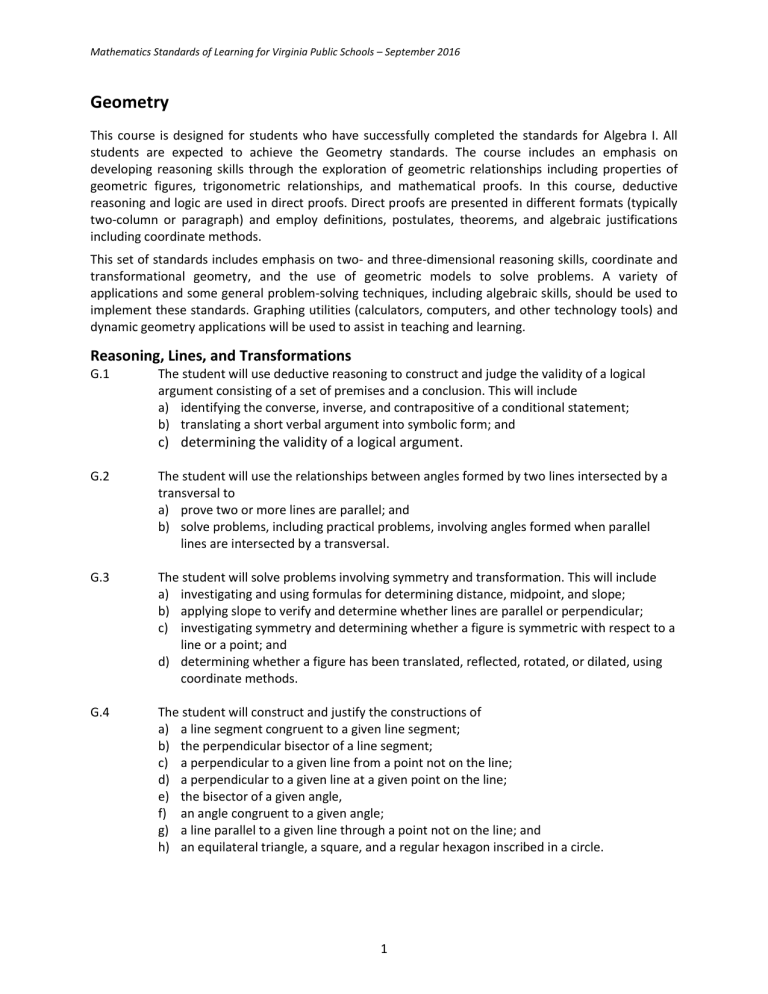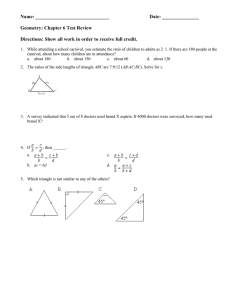
Mathematics Standards of Learning for Virginia Public Schools – September 2016 Geometry This course is designed for students who have successfully completed the standards for Algebra I. All students are expected to achieve the Geometry standards. The course includes an emphasis on developing reasoning skills through the exploration of geometric relationships including properties of geometric figures, trigonometric relationships, and mathematical proofs. In this course, deductive reasoning and logic are used in direct proofs. Direct proofs are presented in different formats (typically two-column or paragraph) and employ definitions, postulates, theorems, and algebraic justifications including coordinate methods. This set of standards includes emphasis on two- and three-dimensional reasoning skills, coordinate and transformational geometry, and the use of geometric models to solve problems. A variety of applications and some general problem-solving techniques, including algebraic skills, should be used to implement these standards. Graphing utilities (calculators, computers, and other technology tools) and dynamic geometry applications will be used to assist in teaching and learning. Reasoning, Lines, and Transformations G.1 The student will use deductive reasoning to construct and judge the validity of a logical argument consisting of a set of premises and a conclusion. This will include a) identifying the converse, inverse, and contrapositive of a conditional statement; b) translating a short verbal argument into symbolic form; and c) determining the validity of a logical argument. G.2 The student will use the relationships between angles formed by two lines intersected by a transversal to a) prove two or more lines are parallel; and b) solve problems, including practical problems, involving angles formed when parallel lines are intersected by a transversal. G.3 The student will solve problems involving symmetry and transformation. This will include a) investigating and using formulas for determining distance, midpoint, and slope; b) applying slope to verify and determine whether lines are parallel or perpendicular; c) investigating symmetry and determining whether a figure is symmetric with respect to a line or a point; and d) determining whether a figure has been translated, reflected, rotated, or dilated, using coordinate methods. G.4 The student will construct and justify the constructions of a) a line segment congruent to a given line segment; b) the perpendicular bisector of a line segment; c) a perpendicular to a given line from a point not on the line; d) a perpendicular to a given line at a given point on the line; e) the bisector of a given angle, f) an angle congruent to a given angle; g) a line parallel to a given line through a point not on the line; and h) an equilateral triangle, a square, and a regular hexagon inscribed in a circle. 1 Mathematics Standards of Learning for Virginia Public Schools – September 2016 Triangles G.5 The student, given information concerning the lengths of sides and/or measures of angles in triangles, will solve problems, including practical problems. This will include a) ordering the sides by length, given angle measures; b) ordering the angles by degree measure, given side lengths; c) determining whether a triangle exists; and d) determining the range in which the length of the third side must lie. G.6 The student, given information in the form of a figure or statement, will prove two triangles are congruent. G.7 The student, given information in the form of a figure or statement, will prove two triangles are similar. G.8 The student will solve problems, including practical problems, involving right triangles. This will include applying a) the Pythagorean Theorem and its converse; b) properties of special right triangles; and c) trigonometric ratios. Polygons and Circles G.9 The student will verify and use properties of quadrilaterals to solve problems, including practical problems. G.10 The student will solve problems, including practical problems, involving angles of convex polygons. This will include determining the a) sum of the interior and/or exterior angles; b) measure of an interior and/or exterior angle; and c) number of sides of a regular polygon. G.11 The student will solve problems, including practical problems, by applying properties of circles. This will include determining a) angle measures formed by intersecting chords, secants, and/or tangents; b) lengths of segments formed by intersecting chords, secants, and/or tangents; c) arc length; and d) area of a sector. G.12 The student will solve problems involving equations of circles. Three-Dimensional Figures G.13 The student will use surface area and volume of three-dimensional objects to solve practical problems. 2 Mathematics Standards of Learning for Virginia Public Schools – September 2016 G.14 The student will apply the concepts of similarity to two- or three-dimensional geometric figures. This will include a) comparing ratios between lengths, perimeters, areas, and volumes of similar figures; b) determining how changes in one or more dimensions of a figure affect area and/or volume of the figure; c) determining how changes in area and/or volume of a figure affect one or more dimensions of the figure; and d) solving problems, including practical problems, about similar geometric figures. 3


